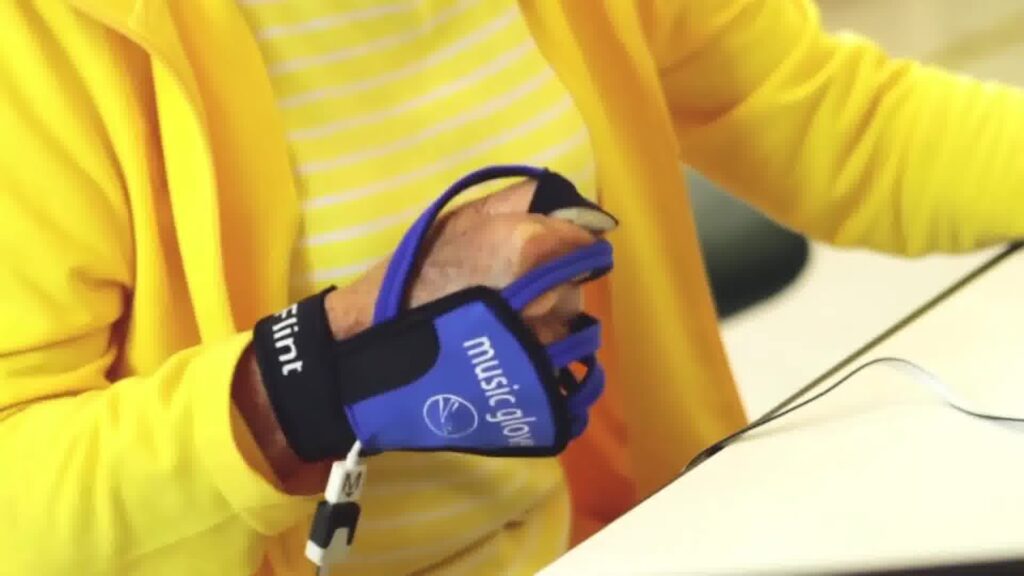Stroke survivors often face a challenging and prolonged recovery process. One of the most significant hurdles they encounter is the loss of hand function, which can affect their ability to perform daily activities such as dressing, eating, or even holding objects. Regaining motor function in the hands is crucial for improving quality of life, but traditional therapy methods can sometimes feel repetitive and disengaging. That’s where MusicGlove comes in, an innovative therapy tool designed to help stroke survivors regain hand function in a fun and interactive way. In this article, we’ll explore how MusicGlove works, its benefits, and why it’s becoming an essential tool in stroke rehabilitation.
What is MusicGlove?
MusicGlove is a clinically proven, FDA-cleared therapy device that helps stroke survivors recover hand and finger mobility. It combines rehabilitative exercises with music therapy to create an engaging and enjoyable rehabilitation experience.
How Does MusicGlove Work?
MusicGlove uses motion-sensing technology to track the movements of the hand and fingers as the user completes various exercises. These exercises are designed to challenge the stroke survivor’s fine motor skills and gradually increase in difficulty as the patient’s abilities improve.
The system works by offering a variety of music-based games, each requiring specific hand movements. As the user interacts with the game, the glove’s sensors detect the precision and range of motion of their hand movements. The device then provides real-time feedback, which is essential for improving motor function. The more accurately the user moves their hand, the better they perform in the game.
MusicGlove’s games are specifically designed to target key motor functions, including hand opening and closing, finger movements, and wrist rotation.
The Benefits of MusicGlove for Stroke Survivors
- Promotes Neuroplasticity
One of the main goals of stroke rehabilitation is to encourage neuroplasticity, which is the brain’s ability to reorganize itself and form new neural connections. After a stroke, parts of the brain that control motor functions may become damaged, making it difficult for the individual to move their limbs. MusicGlove aids neuroplasticity by providing consistent and repetitive movement exercises that stimulate the brain to create new pathways.
The interactive nature of MusicGlove encourages sustained practice, which is essential for promoting neuroplasticity and functional recovery.
- Increased Engagement and Motivation
Traditional physical therapy often involves repetitive exercises that can become monotonous, leading to frustration and a lack of motivation. MusicGlove overcomes this challenge by integrating gamification and music therapy into the rehabilitation process. The combination of therapeutic exercises and engaging music makes the recovery process more enjoyable and motivating.
- Convenient Home-Based Therapy
One of the greatest advantages of MusicGlove is that it allows stroke survivors to complete their therapy in the comfort of their own home. Traditional stroke rehabilitation often requires patients to attend multiple therapy sessions, which can be both time-consuming and costly.
- Real-Time Feedback for Immediate Improvement
Real-time feedback is a powerful feature of MusicGlove. As patients perform exercises, the device provides instant feedback on their movements, helping them understand what they need to improve.
This immediate feedback is essential for improving motor function and reducing frustration. It gives users the confidence that they are performing the exercises correctly, which accelerates the recovery process.
- Personalized Therapy
Every stroke survivor has unique needs and challenges. MusicGlove addresses this by offering personalized therapy plans that are tailored to each user’s abilities. The device adapts the difficulty of the exercises based on the user’s progress, ensuring that they are always working at an appropriate level. Whether a stroke survivor is just beginning their recovery or is in the later stages of rehabilitation, MusicGlove provides an effective and adaptable solution.
The customizable nature of MusicGlove makes it suitable for individuals at various stages of recovery.
Success Stories: Real-Life Impact of MusicGlove
Many stroke survivors have reported significant improvements in hand function after using MusicGlove. By incorporating the device into their daily routine, they have been able to regain the ability to perform essential tasks, such as grasping objects, writing, and eating. Some users have even experienced improved arm and wrist movement as a result of consistent therapy with the device.
One user, a stroke survivor named Jane, shared her experience with MusicGlove: “After using MusicGlove for just a few weeks, I noticed a huge difference in my ability to move my fingers. I could feel my hand getting stronger, and the exercises were actually fun to do. I felt motivated to keep going, which made all the difference in my recovery.”
Conclusion
MusicGlove for stroke survivors is more than just a therapy tool—it’s a transformative rehabilitation device that helps individuals regain hand function through fun, engaging, and scientifically backed exercises. By promoting neuroplasticity, offering real-time feedback, and providing personalized therapy plans, MusicGlove is empowering stroke survivors to take control of their recovery journey. Whether used in conjunction with traditional physical therapy or as a standalone solution, MusicGlove is helping individuals recover more effectively and efficiently, improving their ability to perform daily tasks and leading more independent lives. For stroke survivors, MusicGlove offers hope, motivation, and a pathway to better health and recovery.
Read more: https://theguestblogs.com/locksmith-edmonds-wa-reliable-and-professional-locksmith-services/


